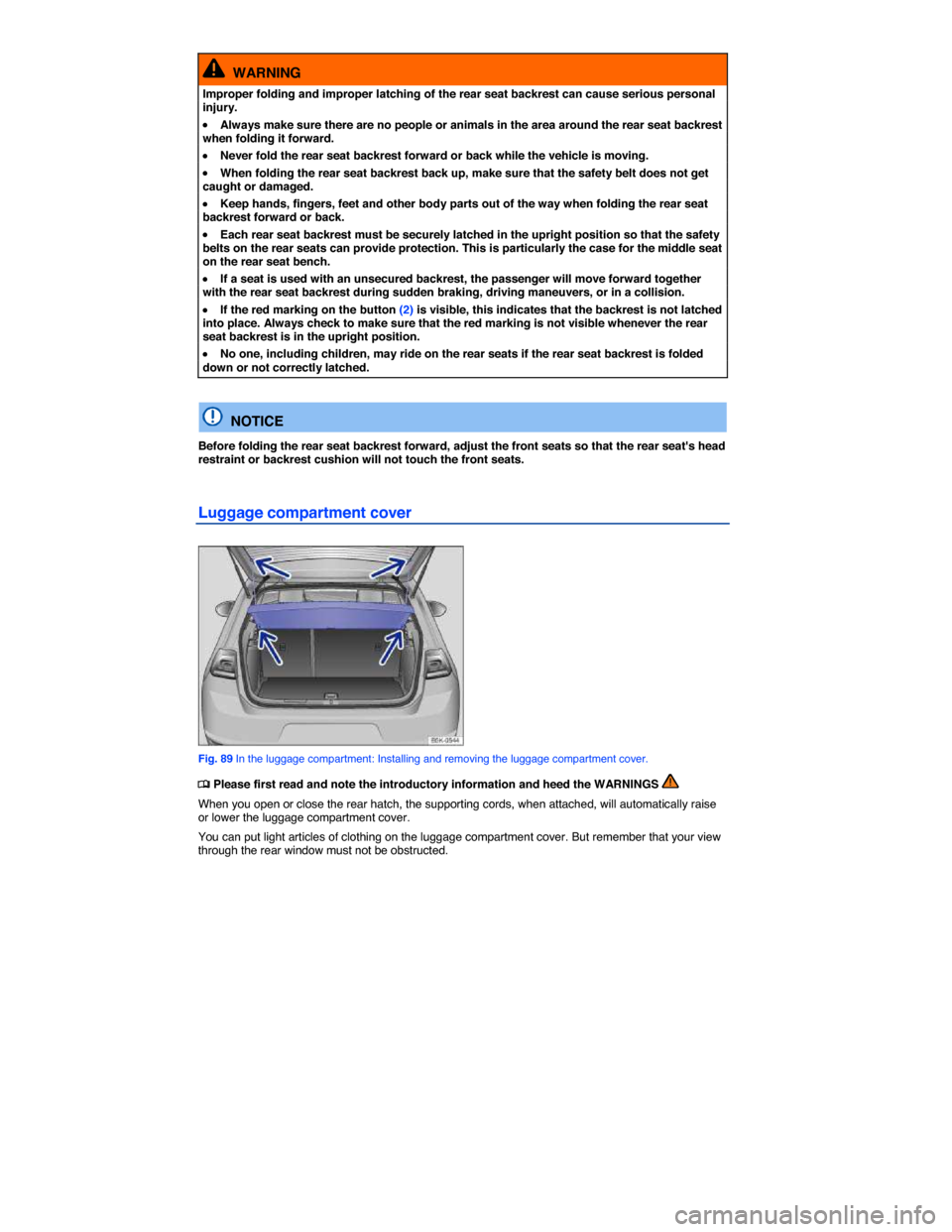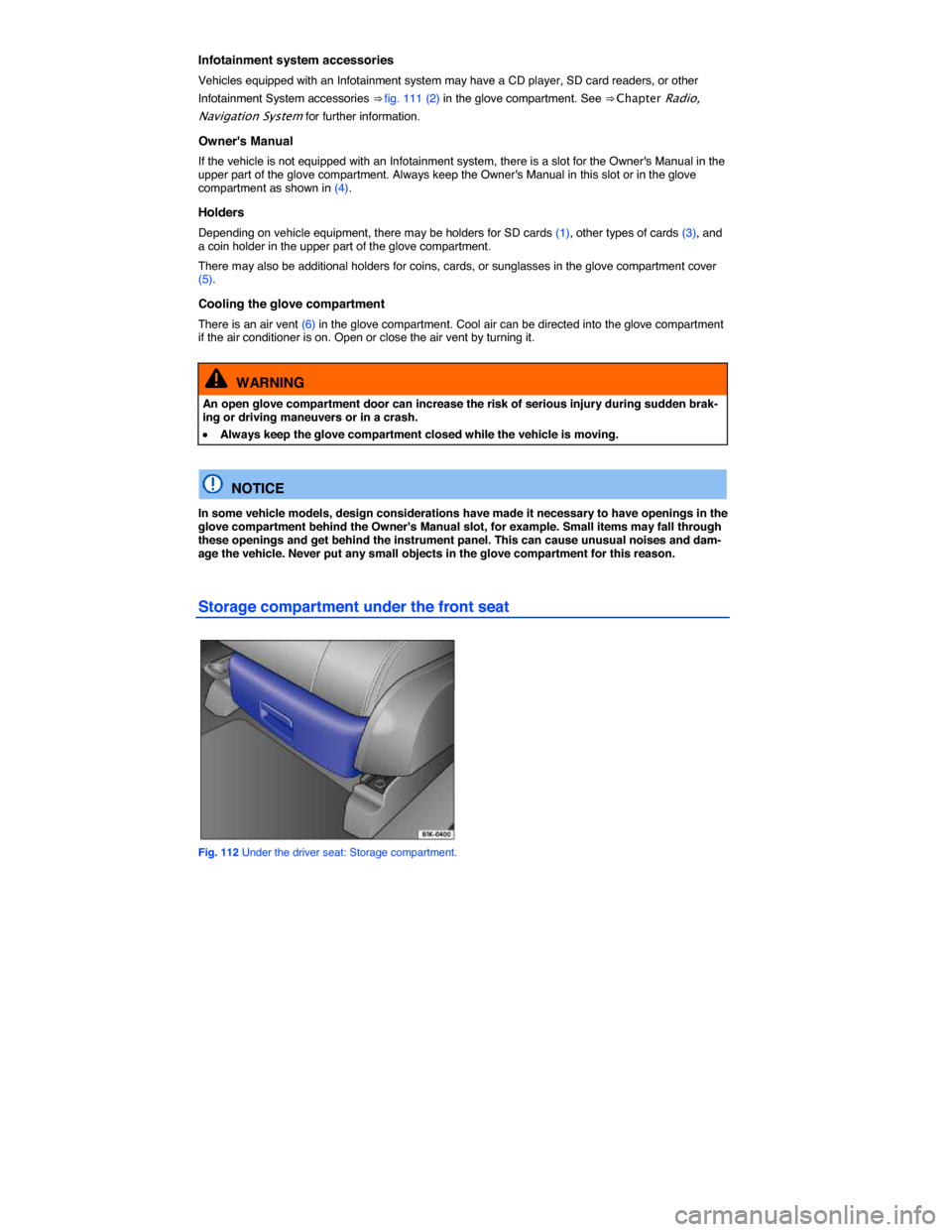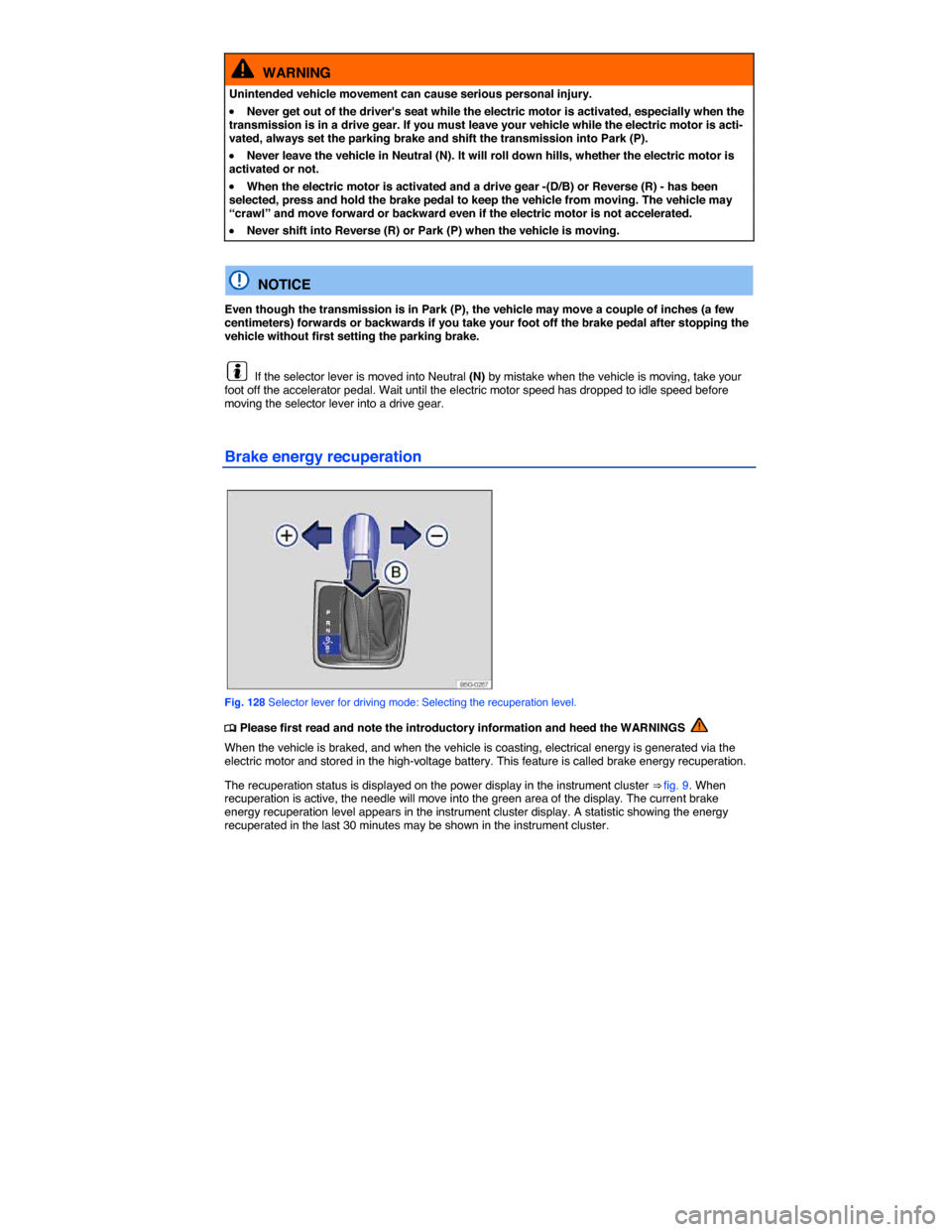2015 VOLKSWAGEN E GOLF while driving
[x] Cancel search: while drivingPage 124 of 394

Possible reasons for changes in the way the rain sensor works
The rain sensor may misread what is happening in the detection zone of its sensitive rain-sensor
surface ⇒ fig. 83 (arrow) and not work for a number of reasons, which may include:
�x Worn out wiper blades: Worn out wiper blades may leave a film of water or wiping streaks; this can cause the wipers to run longer, to wipe more often, or to wipe continuously at high speed.
�x Insects: Insects hitting the windshield may trigger the wipers.
�x Salt streaks: Salt streaks on the windshield from winter driving can cause wiping more often or continuously on glass that is almost dry.
�x Dirt: Caked-on dust, wax, any other buildup on the windshield (lotus effect), or car-wash detergent residue can lower the rain sensor's sensitivity and cause it to react too slowly or not at all.
�x Crack or chip in the windshield: If a stone hits and chips the windshield while the rain sensor is on, this will trigger a wiper cycle. After that, the rain sensor will recognize the change and recalibrate itself to respond to the sensitive surface's reduced detection zone. Depending on the size of the chip, the sensor's reaction pattern may or may not change.
WARNING
The rain sensor cannot always recognize rain and activate the wipers.
�x Switch the wipers on manually when water on the windshield reduces visibility.
Clean the rain sensor's sensitive surface ⇒ fig. 83 (arrows) regularly and check the wiper blades for wear or damage.
To remove wax and coats of polish safely, we recommend using an alcohol-based windshield cleaner.
Checking and refilling windshield washer fluid
Fig. 84 In the electric motor compartment: Cap of the windshield washer fluid reservoir.
�
Page 137 of 394

WARNING
Unsecured or incorrectly stowed items can fly through the vehicle, causing serious personal injury during hard braking or sharp steering or in an accident. Loose items can also be struck and thrown through the passenger compartment by the front airbags if they inflate. To help reduce the risk of serious personal injury:
�x Always stow all objects securely in the vehicle. Always put luggage and heavy items in the luggage compartment.
�x Always secure objects in the passenger compartment properly with suitable straps so that they cannot move into the deployment zone of a side or front airbag during sudden braking, in a sudden maneuver, or in a collision.
�x Always keep storage compartments closed while driving.
�x Never stow hard, heavy, or sharp objects in the vehicle's open storage compartments, on the luggage compartment cover, or on the top of the instrument panel.
�x Always remove hard, heavy, or sharp objects from clothing and bags in the vehicle interi-or and stow them securely in the luggage compartment.
WARNING
Transporting heavy objects causes the handling characteristics of the vehicle to change and increases braking distances. Heavy loads which are not properly stowed or secured in the vehicle can lead to a loss of vehicle control and cause serious personal injury.
�x Transporting heavy items causes the handling characteristics of the vehicle to change by shifting the vehicle's center of gravity.
�x Always distribute luggage evenly and as low as possible within the vehicle. The vehicle capacity weight figures apply when the load is distributed evenly in the vehicle (passengers and luggage).
�x Always stow luggage and heavy items in the luggage compartment as far forward of the rear axle as possible and secure them with appropriate straps to the tie-downs provided.
�x Never exceed the vehicle's Gross Vehicle Weight Rating or Gross Axle Weight Ratings, which are printed on the Safety Compliance Certification Label located on the door jamb of the driver door. Exceeding the permissible weight can cause the vehicle to skid and behave differently.
�x Always adapt your speed and driving style to accommodate your payload and its weight distribution within your vehicle.
�x Be especially cautious and gentle when stepping on the accelerator pedal and avoid sud-den braking and other maneuvers.
�x Brake earlier than you would if you were not driving a loaded vehicle.
NOTICE
The defroster heating wires or antenna in the rear window can be damaged by objects that rub against them.
Page 139 of 394

WARNING
Improper folding and improper latching of the rear seat backrest can cause serious personal injury.
�x Always make sure there are no people or animals in the area around the rear seat backrest when folding it forward.
�x Never fold the rear seat backrest forward or back while the vehicle is moving.
�x When folding the rear seat backrest back up, make sure that the safety belt does not get caught or damaged.
�x Keep hands, fingers, feet and other body parts out of the way when folding the rear seat backrest forward or back.
�x Each rear seat backrest must be securely latched in the upright position so that the safety belts on the rear seats can provide protection. This is particularly the case for the middle seat on the rear seat bench.
�x If a seat is used with an unsecured backrest, the passenger will move forward together with the rear seat backrest during sudden braking, driving maneuvers, or in a collision.
�x If the red marking on the button (2) is visible, this indicates that the backrest is not latched into place. Always check to make sure that the red marking is not visible whenever the rear seat backrest is in the upright position.
�x No one, including children, may ride on the rear seats if the rear seat backrest is folded down or not correctly latched.
NOTICE
Before folding the rear seat backrest forward, adjust the front seats so that the rear seat's head restraint or backrest cushion will not touch the front seats.
Luggage compartment cover
Fig. 89 In the luggage compartment: Installing and removing the luggage compartment cover.
�
Page 192 of 394

Infotainment system accessories
Vehicles equipped with an Infotainment system may have a CD player, SD card readers, or other
Infotainment System accessories ⇒ fig. 111 (2) in the glove compartment. See ⇒ Chapter Radio,
Navigation System for further information.
Owner's Manual
If the vehicle is not equipped with an Infotainment system, there is a slot for the Owner's Manual in the upper part of the glove compartment. Always keep the Owner's Manual in this slot or in the glove compartment as shown in (4).
Holders
Depending on vehicle equipment, there may be holders for SD cards (1), other types of cards (3), and a coin holder in the upper part of the glove compartment.
There may also be additional holders for coins, cards, or sunglasses in the glove compartment cover (5).
Cooling the glove compartment
There is an air vent (6) in the glove compartment. Cool air can be directed into the glove compartment if the air conditioner is on. Open or close the air vent by turning it.
WARNING
An open glove compartment door can increase the risk of serious injury during sudden brak-ing or driving maneuvers or in a crash.
�x Always keep the glove compartment closed while the vehicle is moving.
NOTICE
In some vehicle models, design considerations have made it necessary to have openings in the glove compartment behind the Owner's Manual slot, for example. Small items may fall through these openings and get behind the instrument panel. This can cause unusual noises and dam-age the vehicle. Never put any small objects in the glove compartment for this reason.
Storage compartment under the front seat
Fig. 112 Under the driver seat: Storage compartment.
Page 227 of 394

WARNING
Unintended vehicle movement can cause serious personal injury.
�x Never get out of the driver's seat while the electric motor is activated, especially when the transmission is in a drive gear. If you must leave your vehicle while the electric motor is acti-vated, always set the parking brake and shift the transmission into Park (P).
�x Never leave the vehicle in Neutral (N). It will roll down hills, whether the electric motor is activated or not.
�x When the electric motor is activated and a drive gear -(D/B) or Reverse (R) - has been selected, press and hold the brake pedal to keep the vehicle from moving. The vehicle may “crawl” and move forward or backward even if the electric motor is not accelerated.
�x Never shift into Reverse (R) or Park (P) when the vehicle is moving.
NOTICE
Even though the transmission is in Park (P), the vehicle may move a couple of inches (a few centimeters) forwards or backwards if you take your foot off the brake pedal after stopping the vehicle without first setting the parking brake.
If the selector lever is moved into Neutral (N) by mistake when the vehicle is moving, take your foot off the accelerator pedal. Wait until the electric motor speed has dropped to idle speed before moving the selector lever into a drive gear.
Brake energy recuperation
Fig. 128 Selector lever for driving mode: Selecting the recuperation level.
�
Page 235 of 394

WARNING
Failure to heed warning lights and instrument cluster text messages can cause the vehicle to break down in traffic and result in a collision and serious personal injury.
�x Never ignore warning lights or text WARNINGS.
�x Always stop the vehicle as soon as it is safe to do so.
WARNING
Driving with bad brakes can cause a collision and serious personal injury.
�x If the brake warning light �"�2�!�+�% or �H does not go out, or lights up when driving, either the brake fluid level in the reservoir is too low or there is a fault in the brake system. Stop the
vehicle as soon as you can do so safely and get expert assistance ⇒ Brake fluid.
�x If the brake warning light �"�2�!�+�% or �H lights up at the same time as the ABS warning light �!�"�3 or �J, the ABS may not be working properly. This could cause the rear wheels to lock up rela-tively quickly during braking. Rear wheel brake lock-up can cause loss of vehicle control.
�x If you believe the vehicle is safe to drive, drive slowly and very carefully to the nearest authorized Volkswagen dealer, authorized Volkswagen Service Facility, or other qualified workshop and have the brake system inspected. Avoid sudden hard braking and steering.
�x If the ABS indicator light �!�"�3 or �J does not go out, or if it lights up while driving, the ABS system is not working properly. The vehicle can then be stopped only with the standard brakes (without ABS). You will not have the protection ABS provides. Contact your author-ized Volkswagen dealer or an authorized Volkswagen Service Facility as soon as possible.
�x If the brake pads are worn or you notice changes in the way the vehicle brakes, immedi-ately contact an authorized Volkswagen dealer or authorized Volkswagen Service Facility to have the brake pads checked and, if necessary, replaced.
NOTICE
Failure to heed warning lights or text WARNINGS can result in vehicle damage.
Warning messages when leaving the vehicle
�
Page 237 of 394

Setting the electronic parking brake
You can engage the electronic parking brake any time the vehicle is not moving - even if the ignition is switched off. Always engage the parking brake when you leave or park the vehicle.
�x Pull and hold the button ⇒ fig. 129.
�x The parking brake is engaged when the indicator light �G (arrow) in the button and in the instru-
ment cluster ⇒ Warning and indicator lights lights up.
Releasing the electronic parking brake
�x Switch the ignition on.
�x Press the button ⇒ fig. 129. At the same time, press the brake pedal firmly or press the accelerator pedal lightly if the electric motor is drive ready.
�x The parking brake is released when the indicator light �G (arrow) in the button and in the instru-
ment cluster ⇒ Warning and indicator lights goes out.
Releasing the electronic parking brake automatically when you start driving
The electronic parking brake releases automatically when you start driving if the driver's door is closed and the driver's safety belt is buckled.
Emergency braking function
Only use the emergency braking function in an emergency, when you cannot stop the vehicle using
the brake pedal ⇒ !
�x Pull and hold the button ⇒ fig. 129 to brake the vehicle hard. An audio warning signal will sound at the same time.
�x To stop the braking maneuver, release the button or press the accelerator pedal.
WARNING
Improper use of the electronic parking brake can cause accidents and severe injuries.
�x Never use the parking brake to slow down the vehicle when it is moving, except in an emergency. Braking distance is much longer, since only the rear wheels are braked. Alwa ys use the foot brake.
�x Never press the accelerator pedal when a selector lever position or gear is engaged and the electric motor is drive ready. The vehicle could begin moving, even if the electronic park-ing brake is set.
NOTICE
Even though the transmission is in Park (P), the vehicle may move a couple of inches (a few centimeters) forwards or backwards if you take your foot off the brake pedal after stopping the vehicle without first firmly setting the parking brake.
If the 12-volt vehicle battery is dead, the electronic parking brake cannot be released.
You may hear noises when setting or releasing the electronic parking brake.
If the electronic parking brake is not used for a while, an automatic system check will occasional-ly run when the vehicle is parked. This system check makes audible noises.
Page 239 of 394

mance by applying more pressure to the brake pedal. But, during the break-in period, the stopping distance for hard braking and emergency braking will be longer until the brakes are fully broken in. Avoid hard braking and situations that might require hard braking (such as following other vehicles too closely) – especially during the break-in period.
Brake pad wear depends mostly on operating conditions and the way the vehicle is driven. If you do a lot of city and short-distance driving and/or have a sporty driving style, you should have the brake pads checked by an authorized Volkswagen dealer or authorized Volkswagen Service Facility more often than the regular service intervals.
Wet brakes (for example, after driving through water or washing the vehicle or after heavy rainfall) will not brake as well. Stopping distances will be longer when brake discs are wet or, in winter, even icy. Wet or icy brakes must be dried as soon as possible by carefully applying the brakes a couple of times while traveling at a relatively high speed. Make sure nobody is behind you and that you do not endan-
ger yourself or others ⇒ .
Brakes coated with road salt also react slower and need longer stopping distances. If there is salt on the roads and you are not braking regularly, brake carefully and gently from time to time to remove any
salt coating from the brake discs and pads ⇒ .
Brake disc corrosion (rust) and dirt buildup on the brake pads are more likely to occur if the vehicle is not driven much or is driven only for short distances with little braking. If the brakes have not been used and there is some rust on the discs, clean the brake discs and pads once in a while by carefully braking a couple of times while driving at relatively high speed to help clean the brake discs and pads.
Make sure nobody is behind you and that you do not endanger yourself or others ⇒ .
Brake system malfunction
If you brake and find that the vehicle doesn't brake nearly as well as it used to (sudden increase in stopping distance), a brake circuit may have failed. The brake warning light �H or �"�2�!�+�% will light up and a message may appear in the instrument cluster display. If you believe the vehicle is safe to drive, immediately take it to the nearest authorized Volkswagen dealer or authorized Volkswagen Service Facility for repair. Drive slowly and very carefully, allow for the longer stopping distance, and be ready to push longer and harder on the brake pedal to slow the vehicle down.
Electro-mechanical brake booster
The electro-mechanical brake booster works only when the electric motor is activated. It increases the force on the brakes above and beyond the pressure put on the brake pedal by the driver.
If the electro-mechanical brake booster is not working, you will have to push the brake pedal harder to
make up for the lack of booster assistance and the resulting longer stopping distance ⇒ .
WARNING
New brake pads do not provide maximum braking performance.
�x New brake pads do not have the best stopping power for the first 185 miles (300 km) and must be “broken in.” You can compensate for the slightly reduced braking force by putting more pressure on the brake pedal.
�x Drive with extra care while the new brake pads are being broken in. This reduces the risk of collisions and serious personal injuries due to a loss of control over the vehicle.
�x Never follow other vehicles too closely or put yourself into other situations that might require sudden, hard braking, especially when the brake pads have not been broken in.